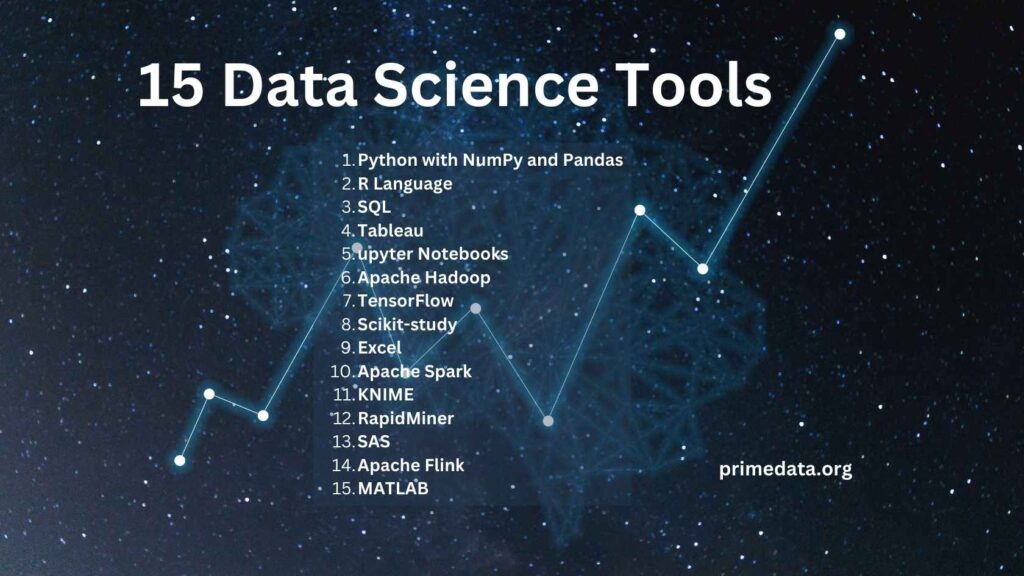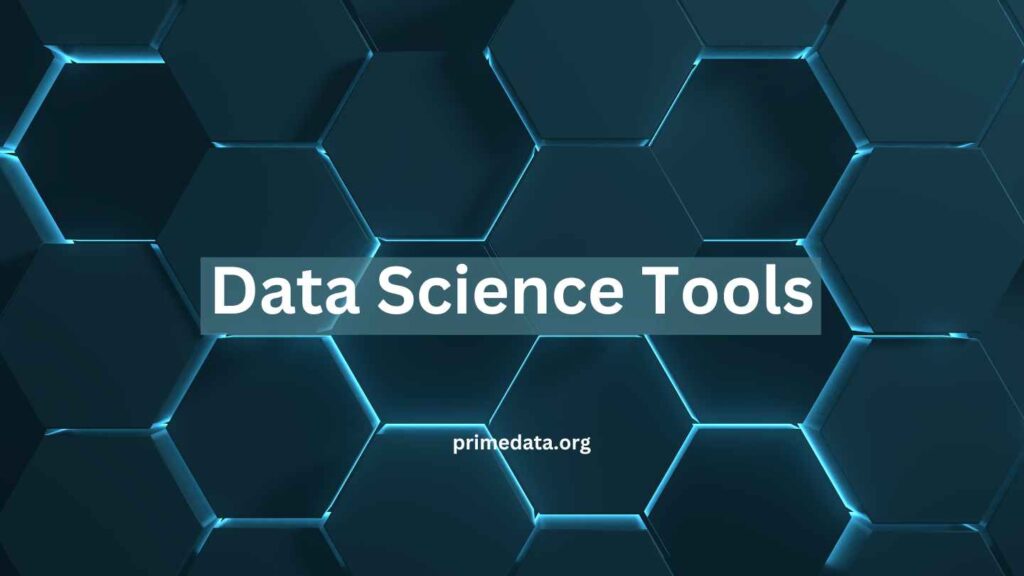Lets dive in the wold of data science tools which you can not ignore. Data Science has become an indispensable part of modern-day organizations and industries, with its capacity to harness the energy of statistics for insights and selection-making. In this article we will explore 15 powerful Data Science Tools that every aspiring statistics scientist, analyst, or commercial enterprise professional should be familiar with.
Data Science Tools
Python with NumPy and Pandas
Python is a flexible and extensively-used programming language within the Data Science community. Its readability, ease of use, and huge library guide make it a desired choice for information experts.
NumPy is a fundamental library for numerical computing in Python, imparting assistance for big, multi-dimensional arrays and matrices. It includes a huge variety of mathematical capabilities to perform array operations successfully.
Pandas are every other crucial library that builds upon NumPy, imparting effective information systems like Series (1-dimensional) and DataFrame (2-dimensional) for statistics manipulation and analysis. It simplifies duties such as data cleansing, filtering, grouping, and merging, making it fundamental for fact dispute.
R Language
R is a specialized programming language for statistical computing, data analysis, and visualization. It has a rich circumstances of applications catering to numerous statistical methodologies and device-studying algorithms. R’s strong plotting skills and statistical capabilities make it a top preference for academic information analysts and researchers.

SQL
Structured Query Language (SQL) is a domain-unique language used for coping with and querying relational databases. It lets users interact with databases to retrieve, update, and manipulate information. SQL is essential for facts professionals as maximum information is stored in relational database control systems (RDBMS), and SQL permits them to access and manner records successfully.
Tableau
Tableau is a main information visualization device that empowers customers to create interactive and visually attractive dashboards and reports. Its drag-and-drop interface lets users visualize information without considerable coding know-how. Tableau’s real-time facts connection and seamless integration with diverse data sources make it a crucial tool for commercial enterprise intelligence and records-pushed decision-making.
Jupyter Notebooks
Jupyter Notebooks provide an interactive computing environment for information evaluation and exploration. Users can combine stay code, visualizations, and explanatory text in a single document, making it best for collaborative statistics initiatives. Its guide for numerous programming languages, which include Python and R, complements its versatility and utility.
Apache Hadoop
Apache Hadoop is an open-source framework designed for the allotted storage and processing of huge datasets and the usage of clusters of commodity hardware. Hadoop’s distributed report device (HDFS) enables the storage of large amounts of statistics, while its MapReduce programming model enables dispensed processing throughout nodes, allowing green statistics evaluation.
TensorFlow
Developed using Google, TensorFlow is a famous open-source device gaining knowledge of a library that makes a specialty of deep mastering and neural networks. Its bendy structure lets customers create complex computational graphs for diverse device studying responsibilities, image recognition, herbal language processing, etc.
Read More: Data Science: Unraveling the Secrets of the Digital Age
Scikit-study
Scikit-analyze is a flexible and consumer-friendly gadget getting-to-know library for Python. It gives a huge range of algorithms for duties, including class, regression, clustering, dimensionality reduction, and greater. Scikit-analyze’s ease of use and sizeable documentation make it a go-to desire for the device to get to know practitioners.
Excel
Microsoft Excel is a spreadsheet software widely used for records analysis, visualization, and reporting. Although not a specialized Data Science device, Excel’s familiarity, ease of use, and basic analytical functions make it precious for brief insights and statistics manipulation, particularly for small datasets.
Apache Spark
Apache Spark is an open-source disbursed statistics processing engine that excels at huge statistics processing. It supports in-memory statistics processing, reducing the want for disk I/O and accelerating statistics operations. Spark gives a unified platform for batch processing, actual-time streaming, device studying, and graph processing.
KNIME
KNIME (Konstanz Information Miner) is an open-source facts analytics platform enabling customers to create records workflows visually. It gives various integrated tools for statistics blending, transformation, modeling, and visualization, making it available to each facts scientists and non-technical customers.
RapidMiner
RapidMiner is a user-pleasant records technological know-how platform that helps the end-to-cease facts evaluation technique. It affords an intuitive drag-and-drop interface for constructing information models, in addition, to support for system studying and predictive analytics.

SAS
SAS (Statistical Analysis System) is a complete suite of software gear for superior analytics, enterprise intelligence, and records control. It is extensively utilized in diverse industries for its reliability, protection features, and compliance with regulatory necessities.
Apache Flink
Apache Flink is an open-supply flow processing framework for real-time information streaming and occasion-pushed packages. Flink helps process event time, fault tolerance, and stateful computations, making it perfect for complicated streaming records.
MATLAB
MATLAB is an effective numerical computing environment for rules improvement, information evaluation, and visualization. It gives an in-depth collection of mathematical functions, toolboxes, and plotting abilities, making it a valuable tool for engineers and researchers.
Conclusion
In conclusion, mastering those 15 Data Science gear is crucial for every person venturing into the sector of information-pushed choice-making. Whether you are a pro facts professional or just starting your adventure, leveraging those gear will undoubtedly improve your productivity and proficiency in the captivating area of Data Science. So, roll up your sleeves and dive into the exciting international of Data Science, armed with the necessary gear!
Frequently Asked Questions (FAQs)
What is Data Science?
Data Science is an interdisciplinary area that specializes in extracting insights and know-how from facts and the usage of statistical, computational, and area knowledge.
Why is Python famous in Data Science?
Python is popular in Data Science because of its clarity, versatility, and wealthy libraries like NumPy and Pandas, which facilitate information manipulation and evaluation.
What is SQL used for in Data Science?
SQL is used for querying and handling relational databases, allowing data professionals to get admission to and manipulate data effectively.
How does Tableau benefit records analysts?
Tableau permits statistics analysts to create interactive and visually appealing dashboards and reports, facilitating data visualization and enterprise intelligence.
What are the key features of Apache Spark?
Apache Spark excels in big data processing with its in-memory data processing, support for real-time streaming, and unified platform for various data tasks like machine learning and graph processing.
